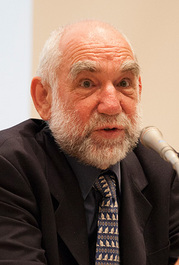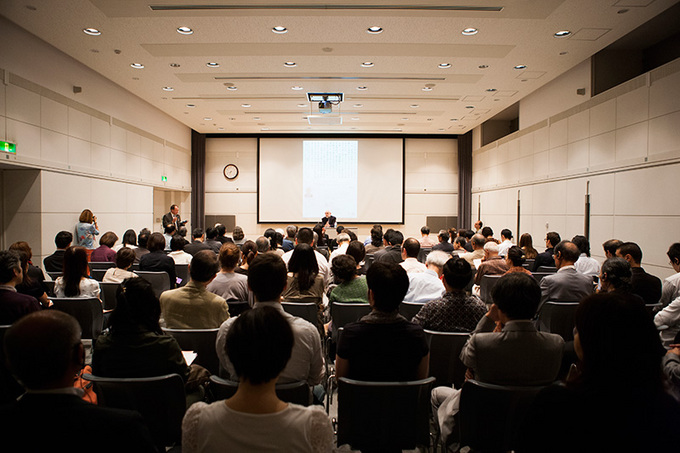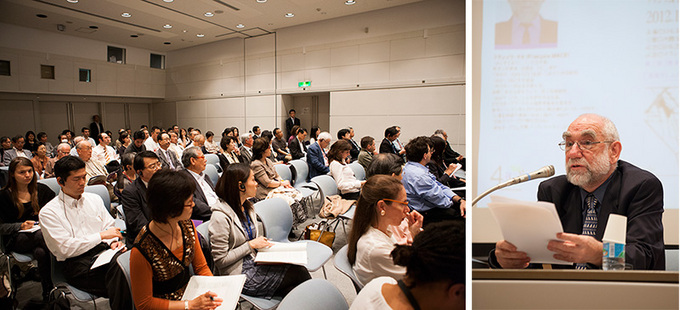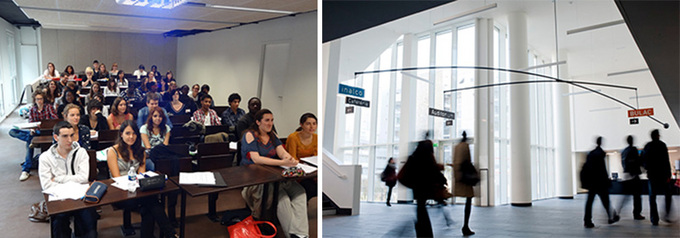The Kojiki, a Long Forgotten Aeneid?--A Hypothesis from a French Researcher
François Macé
Professor of the National Institute of Oriental Languages and Civilizations (INALCO)

Lecture "The Kojiki, a long forgotten Aeneid?--A hypothesis from a French researcher" by Professor François Macé of INALCO at the Maison Franco-Japonaise on October 11, 2012, in Tokyo
Why compare the Kojiki with the Aeneid, the epic poem of ancient Rome?
I am sure the first question that springs to mind is why I should refer to the Aeneid, the epic poem by the Roman poet Virgil, to talk about the Kojiki (Record of Ancient Matters). The Kojiki and the Aeneid seem so far apart with nothing in common.
The idea for this comparative study came to me as I was reading Rome, la ville sans origine by Florence Dupont. In the book, the author ponders the question why the epic poem Aeneid was born despite the plentiful and varied lore on the founding of Rome. The Romans also had another means to convey the Roman history besides the epic poem. Livy (59BC-AD17), a contemporary of the Aeneid's author Virgil (70BC-19BC), left us a monumental account of the history of Rome in 142 books, covering from its foundation until the year 9BC.
This coexistence of a literary work and historical work in the same period seemed familiar to me. It was the Kojiki (compiled in 712) and Nihon Shoki (compiled in 720), the two contemporary texts that deal with the subject of the ancient history of Japan. They shared the same purpose of legitimizing the ruling family, but are fundamentally different in nature.
The Nihon Shoki is a chronicle of the history of Japan based on the Chinese model of historical writing. With the exception of the first two books, the 28 others are written in the form of chronicles, documenting important events with dates. Meanwhile, the Kojiki supplies little detail in terms of years and dates. There are only about 15 such entries, regarding the deaths of certain emperors. The Kojiki does not even mention important events after the reign of the 24th sovereign, Emperor Ninken (449-498), onwards.
Then, why did historical events go undocumented in the Kojiki? In my opinion, it was not because they were not recognized as major events, but probably because they did not fit the principles of the narrative of the ancient times, of furugoto or "ancient matters," suggested by the title of the work. The answer to the question may rest in the fact that a large part of the Kojiki is comprised of myths. Japanese myths are documented in its first book which deals with the Age of the Gods. Yet this first book had been long forgotten, even in the world of Shinto until the Edo period. Despite the fact that a third of the Kojiki is dedicated to the Age of the Gods, people during the ancient, medieval, and a major part of the Edo period, referred to and quoted from the first two books of the Nihon Shoki which also describes the Age of the Gods, just like the Kojiki. Thus, what is this Kojiki, which mentions the ancient times not as a historical document, and was long forgotten from the Nara period to late Edo period?
Looking at the various circumstances, one can reasonably assume that there is no text that serves as the basis for the Kojiki. But then again, it is not as if the Kojiki created a new genre. There are no works that have followed or have been inspired by the Kojiki, and it exists as a singular work in the Far East. It is for this reason that I believe a comparison with the Aeneid allows us to gain a better understanding of its nature. The Kojiki may seem unusual in the Japanese literary landscape, but it becomes less strange when compared to works of other cultures like the Aeneid.
The literary significance of the Kojiki
The two works, the Kojiki and the Aeneid, were written soon after civil wars when memories were still fresh in peoples' minds. The victory of Octavian, the future Augustus (63BC-AD14), at the Battle of Actium against Cleopatra's fleet in 31BC led to the end of the civil war, subsequent to the suicide of his biggest rival Antony. The plans for writing the Aeneid had already been undertaken in 29BC.
In Japan, the Jinshin War resulted in the victory of Prince Oama, later Emperor Temmu (c.631-686), over his nephew Prince Otomo (648-672) in 672, and in 681, he ordered a group of princes and government officials to transcribe genealogies and ancient matters. This compilation probably became the material for the Nihon Shoki as well as the Kojiki.
The Kojiki indirectly attempted to claim the legitimacy of the new rulers by recounting their roots, as does the Aeneid. It is hardly surprising to see a description in the writings that the princely lineages are led back to divine ancestors: Venus in the case of Rome and Amaterasu in Japan.
Augustus was worshipped as a god in his lifetime in certain parts of the empire. At the same time, Emperor Temmu was probably the first Japanese sovereign to wear the title of tenno, in other words, 'son from the heavens' or 'celestial sovereign.' The use of myths for political purposes is obvious in both cases. But works produced to simply realize political objectives very rarely survive as literary work. The Aeneid is read even today because it is primarily a literary work. I am not a specialist in Latin literature, but I believe I am not going too far to say that this epic represents one of the pinnacles of literature in terms of its scale, quality of language, finesse of descriptions, and aptness of the psychology of the characters.
While the literary qualities of the Aeneid have always been deemed to be evident, the question is more complex with regards to the Kojiki. First of all, there is the problem of language. O no Yasumaro (unknown-723), considered as the one who compiled and transcribed the Kojiki, explains in the preface that he combined phonetic transcription and use of Chinese to write down the text which was originally recited in Japanese. His method resulted in the text that is difficult to understand.
If the Kojiki has literary significance, it must be perceived in elements other than its diction. Although the Kojiki has been given the status of a major literary work today, its current prestige may be based partially on misunderstandings. The Kojiki is mostly read through yomikudashi, meaning 'reading the Chinese letters phonetically', since the original text does not allow for a single, indisputable way of reading. Furthermore, we tend to read it quickly, skipping the long genealogies with endless names. Modern readers are most interested in the narratives, those of the gods, heroes, or the songs in the third book. But what hits us above all is the excitement of having the oldest Japanese text in our hands. The idea that it is so ancient makes a text allow us to feel we are witnessing the actual origin of the Japanese language and literature.
But this is historically indefensible. We have already discovered other works preceded the Kojiki, some by more than a hundred years. Thus, the Kojiki does not possess the plainness and simplicity which we tend to too easily expect from ancient texts.
The Kojiki for Motoori Norinaga
The great scholar Motoori Norinaga (1730-1801) of the 18th century did not have literary criteria in the foreground of his studies. He was seeking the origin of the pure Japanese spirit, which had not been contaminated yet by various elements of continental civilization. Motoori Norinaga, in his monumental commentaries titled the Kojikiden, brought the Kojiki back from the shadows of history. He explicated it so intelligibly and made it into something for the Japanese to be proud of. But he did not seek literary excitement in the Kojiki. The model for that would always be The Tale of Genji. Neither did he seek examples of poetry in the Kojiki or the Nihon Shoki in both of which rustic songs sometimes appear. His taste was rather for the sophisticated waka poems of the Shin Kokin Wakashu. For him, the Kojiki was something that spoke the language of the gods and provided the truth about the Age of the Gods and beginnings of the Human Age. His text for the Kojiki is on the level of faith. His work was of the order of mystic erudition.
A comparison with the Aeneid allows us to break free from the purely Japanese or even nationalistic interpretations by Motoori Norinaga's successors. Even if the gods are very present in the Latin poem, we know the Aeneid is not a religious text. It was conceived as a literary text in a specific political and religious context.
My hypothesis is that it could be probably the same for the Kojiki. There are no grounds that should lead us to think that the Kojiki played a direct religious role. We find no testimony of its recitation during rites. Compared with the Aeneid, the Kojiki certainly covers a much longer span of time, but the important matter is the question of its roots, as with the Roman epic. If the Kojiki does not speak of the reign of Emperor Ninken, and the Aeneid also ends with the victory of Aeneas, it is because essential matters have already been noted and all else is unnecessary. They are not simply chronicles of past events, but they deal with the original age preceding all the facts of the foundation of the country.
To think about the present by reaffirming the beginnings
With regards to literary form, I believe that the Kojiki is an epic poem written by an intellectual, as with the work of Virgil. The Aeneid has motifs that are repeated in both the Age of Gods and Human Age, and similarly the Kojiki also has many elements that are set up to be in contrast with or echo each other. It is doubtless that there lies the richness of the Kojiki, but that is probably why it had also been overlooked for such a long period.
I believe the Kojiki has a structure comparable to a fixed-form poem. It consists of sophisticated contrasts between water and fire, things open and closed, distant and close, and this might have been a familiar form for the people of the courts in the 7th century to the early 8th century. But this form must have already begun to be perceived as old-fashioned at that time. For the elite who were rapidly leaning towards Chinese culture, this should have already become incomprehensible. They had begun to see and understand the world through the theory of Yin-Yang and the Five Elements that came to Japan from the continent.
This process was already seen in the Nihon Shoki. It did not hesitate to use the terms of yin and yang in describing the gods Izanagi and Izanami, the couple who created the world. In this way, the theory of Yin-Yang and the Five Elements would be used to interpret the narratives of the Age of Gods, as with the Nihon Shoki, until the works of kokugaku, meaning "national studies" in the Edo period.
Thus, the Kojiki was doubly depreciated. Firstly, its language was not clear enough to gain the prestige as the Aeneid did. Furthermore, O no Yasumaro was a middle-class government official unlike Virgil, who was already an esteemed poet to his contemporaries. What if the Kojiki had been written by Kakinomoto no Hitomaro (660-720) who is praised for his literary talent even today? What kind of work would it have become?
Kakinomoto no Hitomaro wrote a long elegy for the funeral of Prince Kusakabe, husband of Empress Gemmei. This elegy begins, as with the Kojiki, with the creation of heaven and earth and the descent of the celestial grandson, as whom Kakinomoto no Hitonomaro identifies the Emperor Temmu, the father of Prince Kusakabe. In these verses, he presents the same program shown in the Kojiki. But this long and magnificent elegy consists of 76 verses and two envois, and is therefore far from an epic poem. Japan did not have a tradition of long epic poems at the end of the 7th century. Thus, the furugoto or "ancient matters" must have been passed on in narratives in prose.
But when reading the Kojiki, it partially refers to furugoto that can be described only as mythological references. When the Kojiki was put down in writing, the furugoto that was referred to probably belonged to a world which was disappearing in the oncoming waves of Chinese thought, nevertheless the furugoto were being revived in the Temmu reforms which attempted to restore ancient things. The Aeneid participated in and benefited from Augustus' religious revolution and restoration. The Kojiki also implies the existence of a plan that was not quite successful. During the Temmu era, the rites of emperors succession and rituals of Ise Shrine were adopted in forms following ancient ways. The regular reconstruction of the buildings of the Ise Shrine also began under the reign of Empress Jito (645-703), the widow of Temmu. The construction style with thatched roofs and posts that are built directly into the ground, has been still maintained today. It may be said they are in striking contrast with Chinese architecture. Furthermore, the Ise Shrine constructed a pavilion for the rites of the Daijosai, one of the major ceremonies for the emperors succession, and this pavilion is also built in an ancient style. But these kinds of movements to restore ancient ways did not last. They did not find resonance in a culture dominated by Chinese thought and Buddhism. The vision of making history from past events that had come to Japan from China prompted the elite to place importance on history in the form of official stories, and the Nihon Shoki and Zoku Nihon Shoki followed that flow of history based on this form.
Therefore, Motoori Norinaga was not entirely mistaken in seeking the authentic Japanese soul in the Kojiki. But objectively speaking, it must be stated that what he considered to be the essential truth of the Age of the Gods beyond history was actually a literary work that was deliberately created in an archaic manner. Even so, it is certain that Motoori Norinaga had perceived this unique book in Japanese literature as the work having an intention to present the beginnings of heaven and earth in a literary form of an epic and beautiful narrative.
But, just as the Aeneid will never teach us anything about the factual truth of the foundation of Rome, neither will the Kojiki tell us anything about the events that happened in Japan before the 6th century. This is not the role of myths or literature. The two texts that are seemingly different fulfill the same role, each at its own level: to think of the present by reaffirming the beginnings. The reason why this work still continues to move us today is this song praising of the beginnings, thanks to an internal coherence which we do not always need to be aware of for it to be effective.
Lecture photos: Kenichi Aikawa
Other photos: Courtesy of INALCO
 François Macé
François Macé
Born in 1947, Professor of the Department of Japanese Language and Civilization at the National Institute of Oriental Languages and Civilizations (INALCO) since 1989. Served as Dean of the department from 1990 to 1997. Mainly teaches history of thought and religion before the Meiji era. Major publications include La mort et les funérailles dans le Japon ancient (POF, 1986), Kojiki shinwa no kozo (Chuokoron-sha, 1989), and Le Japon d'Edo (co-authored with Mieko Macé, Belles Lettres, 2006).
Department of Japanese Language and Civilization, National Institute of Oriental Languages and Civilizations (INALCO) [France], a recipient of the Japan Foundation Awards (2012)
The first Japanese-language course in France opened in 1862. This marked the beginning of Japanese-language education in France and the department which is now one of the largest institutions in Europe. Over the years, the department has produced many translators, teachers of Japanese-language, diplomats and distinguished scholars in the broad field of Japanese studies. It plays an essential role in the French-Japanese relationship.
The Japan Foundation and INALCO
INALCO and the Japan Foundation has been working together to promote Japanese Studies and Japanese language education in France and other part of Europe. The two institutions have held conferences and symposia to promote Japanese culture and literature in France. (ex. "La cithare japonaise dans le Roman du Genji" (2012), "L'essor de la photographie au Japon, 1900-1945" (2009)) Some of the researchers of INALCO were awarded Japanese Studies Fellowships from the Foundation. The Foundation has donated various books related to Japanese Studies and materials for learning Japanese language to INALCO.
Related Events
Keywords
- Literature
- Philosophy/Religion
- History
- The Japan Foundation Awards
- Japan
- France
- National Institute of Oriental Languages and Civilizations
- Ancient Rome
- Kojiki
- Epic
- Aeneid
- Virgil
- Florence Dupont
- Livy
- Nihon Shoki
- Augustus
- Cleopatra
- Antony
- Jinshin War
- Emperor Temmu
- Prince Otomo
- Latin literature
- O no Yasumaro
- Motoori Norinaga
- The Tale of Genji
- Shin Kokin Wakashu
- Edo period
- Kakinomoto no Hitomaro
- Ise Shrine
- Empress Jito
- Chinese philosophy
- Buddhism
- Zoku Nihon Shoki
Back Issues
- 2025.7.31 HERALBONY's Bold Mis…
- 2024.10.25 From Study Abroad in…
- 2024.5. 2 People-to-People Exc…
- 2022.11. 1 Inner Diversity<3> <…
- 2022.9. 5 Report on the India-…
- 2022.6.24 The 48th Japan Found…
- 2022.6. 7 Beyond Disasters - …
- 2021.3.10 Crossing Borders, En…
- 2020.7.17 A Millennium of Japa…
- 2020.3.23 A Historian Interpre…






